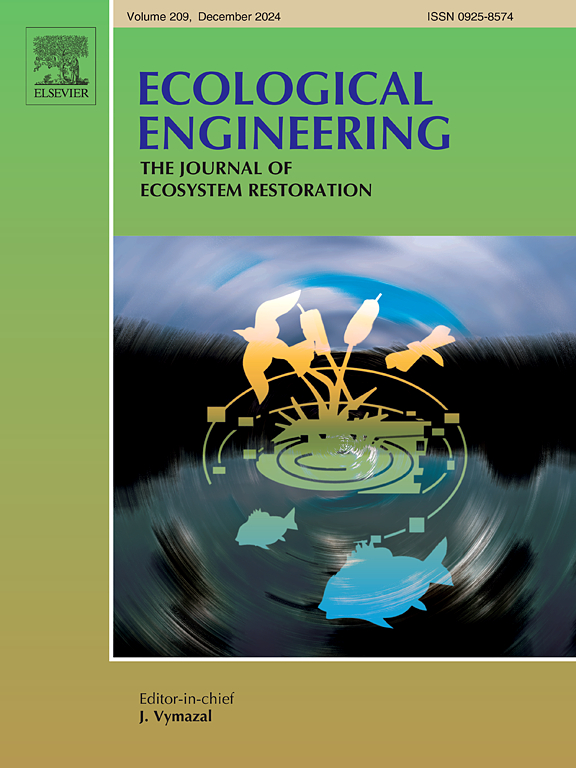铝土矿开采土壤上咖啡种植园的温室气体排放:管理肥料和覆盖作物
IF 4.1
2区 环境科学与生态学
Q1 ECOLOGY
引用次数: 0
摘要
控制对土壤和环境影响的替代方案对于铝土矿开采后农业用地的再利用是重要的。在本研究中,我们评估了在铝土矿开采的复垦土壤上重建咖啡种植园时,有机肥和矿肥对土壤有机碳(SOC)库、咖啡(Coffea arabica)豆产量和土壤温室气体(GHG)排放的影响。试验采用裂区设计,共4个重复。主地块施用3种施肥方式:不施肥(NF)、矿物施肥(MF)和家禽凋落肥(PL)。在小样地中,考虑无覆盖作物区(-CC)和有褐藻区(+CC)。测量了8个月的温室气体通量(CO2、CH4和N2O),并在测量结束时计算了每种温室气体的累积通量、全球变暖潜势、碳管理指数和土壤C-CO2相对排放量。测定了两季土壤有机碳(SOC)、易氧化碳(KMnO4-C)含量和咖啡豆产量。我们发现咖啡种植园之间的ruziziensis提供了较低的相对二氧化碳排放量。施用PL的咖啡园土壤的CO2和N2O排放量较高,不同处理间的CH4外排行为相似。与MF和NF处理相比,家禽凋落物的累积土壤N2O通量分别增加了约87%和98%。与+CC和MF处理相比,-CC和MF处理咖啡树土壤中CH4的累积外排量增加了75.8%。-CC和MF处理的相对二氧化碳排放量增加了31%。另一方面,与-CC区相比,紫杉树与PL联合施用的土壤有机碳含量提高了23.80%。咖啡林间+CC处理的KMnO4-C含量和碳管理指数也较高。然而,在-CC中,施用PL的咖啡豆产量最高(46 sc ha - 1),其次是施用MF (25 sc ha - 1)。本研究表明,在铝土矿开采后,禽畜粪便和乌氏菌的联合利用可以恢复土壤有机碳。没有植被覆盖的鸡窝有助于提高产量;然而,它提供了更大的累积外排和温室气体排放。我们的研究结果强调了在铝土矿开采土壤上进行开垦的咖啡种植园进行适当土壤管理的重要性。本文章由计算机程序翻译,如有差异,请以英文原文为准。

GREENHOUSE gas emissions in coffee plantations on a bauxite-mined soil undergoing reclamation: Management fertilizer and cover crop
Alternatives that control the impacts on the soil and the environment are important for reusing agricultural lands after bauxite mining. In this study, we evaluated the effects of organic and mineral fertilization with or without cover crops on soil organic carbon (SOC) pools, coffee (Coffea arabica) bean yield, and soil greenhouse gas (GHG) emissions in the reestablishment of coffee plantations on a bauxite-mined soil undergoing reclamation. The experiment consisted of a split-plot design with four replicates. The main plot received three types of fertilization: nonfertilization (NF), mineral fertilization (MF), and poultry litter (PL). In subplots, an area without cover crops (-CC) and another with Urochloa ruziziensis (+CC) were considered. GHG fluxes (CO2, CH4 and N2O) were measured over eight months, and the accumulated fluxes for each GHG, global warming potential, carbon management index, and soil C-CO2 relative emissions were calculated at the end of the measurements. The soil organic carbon (SOC), easily oxidable carbon (KMnO4-C) contents and coffee bean yield were also measured in two seasons. We found that Urochloa ruziziensis between the coffee plantations provided lower relative CO2 emissions. CO2 and N2O emissions were higher in soils with coffee plantations fertilized with PL. The CH4 efflux behavior between the treatments was similar. The accumulated soil N2O flux, with the poultry litter increases by approximately 87 % and 98 % in relation to MF and NF treatments, respectively. The accumulated efflux of CH4 in the soil of coffee trees planted -CC and MF treatments was 75.8 % higher than that +CC and MF treatments. The -CC and MF treatments contributed 31 % more to the relative CO2 emissions. On the other hand, the combination of U. ruziziensis and PL application provided a total SOC 23.80 % higher than that in the -CC areas. The KMnO4-C content and carbon management index were also higher in treatments with +CC between the coffee plantations. However, the highest production of coffee beans was with PL application (46 sc ha−1) followed by MF (25 sc ha−1) in the -CC. Our study presents evidence that the combined use of poultry litter and U. ruziziensis allows the recovery of SOC following bauxite mining. Poultry litter without vegetation cover contributes to higher production; however, it provides greater accumulated efflux and GHG emissions. Our findings highlight the importance of adequate soil management in coffee plantations on a bauxite-mined soil undergoing reclamation.
求助全文
通过发布文献求助,成功后即可免费获取论文全文。
去求助
来源期刊

Ecological Engineering
环境科学-工程:环境
CiteScore
8.00
自引率
5.30%
发文量
293
审稿时长
57 days
期刊介绍:
Ecological engineering has been defined as the design of ecosystems for the mutual benefit of humans and nature. The journal is meant for ecologists who, because of their research interests or occupation, are involved in designing, monitoring, or restoring ecosystems, and can serve as a bridge between ecologists and engineers.
Specific topics covered in the journal include: habitat reconstruction; ecotechnology; synthetic ecology; bioengineering; restoration ecology; ecology conservation; ecosystem rehabilitation; stream and river restoration; reclamation ecology; non-renewable resource conservation. Descriptions of specific applications of ecological engineering are acceptable only when situated within context of adding novelty to current research and emphasizing ecosystem restoration. We do not accept purely descriptive reports on ecosystem structures (such as vegetation surveys), purely physical assessment of materials that can be used for ecological restoration, small-model studies carried out in the laboratory or greenhouse with artificial (waste)water or crop studies, or case studies on conventional wastewater treatment and eutrophication that do not offer an ecosystem restoration approach within the paper.
 求助内容:
求助内容: 应助结果提醒方式:
应助结果提醒方式:


